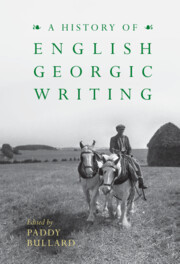Book contents
- A History of English Georgic Writing
- A History of English Georgic Writing
- Copyright page
- Contents
- Contributors
- A Note on National Designations
- Abbreviations
- Introduction
- Part I Turnings
- Chapter 1 Hesiod, Virgil and the Ambitions of Georgic
- Chapter 2 Turning, Flying
- Chapter 3 Farm Diaries, 1770–1990
- Chapter 4 Twentieth-Century Georgic and Agricultural Technology
- Part II Times
- Part III Territories
- Bibliography
- Index
Chapter 1 - Hesiod, Virgil and the Ambitions of Georgic
from Part I - Turnings
Published online by Cambridge University Press: 01 December 2022
- A History of English Georgic Writing
- A History of English Georgic Writing
- Copyright page
- Contents
- Contributors
- A Note on National Designations
- Abbreviations
- Introduction
- Part I Turnings
- Chapter 1 Hesiod, Virgil and the Ambitions of Georgic
- Chapter 2 Turning, Flying
- Chapter 3 Farm Diaries, 1770–1990
- Chapter 4 Twentieth-Century Georgic and Agricultural Technology
- Part II Times
- Part III Territories
- Bibliography
- Index
Summary
The origins of modern georgic writing lie in the ancient Mediterranean, in the literature of ancient Greece and Rome. On the Greek side the genre begins with the poetry of Hesiod, embraces dozens of treatise in poetry and prose written during the Hellenistic era, and comes to an end in Byzantine times with the massive compilation of farming lore known as the Geoponica. Latin georgic starts with Cato’s essay on agriculture, culminates in Vergil’s Georgics – the poem that defined the genre for later European authors – and persists in the Latin prose of Columella, Pliny, and Palladius. The diversity of the genre evades definition. Its popularity is unsurprising in the context of a world where wealth meant ownership of land and most people tilled the soil.
- Type
- Chapter
- Information
- A History of English Georgic Writing , pp. 39 - 56Publisher: Cambridge University PressPrint publication year: 2022

